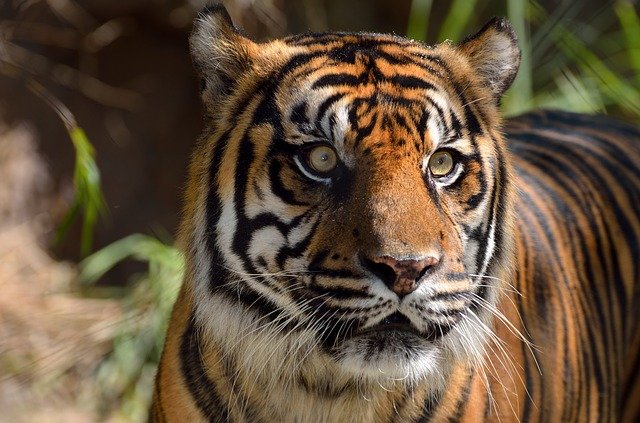Why are Tigers endangered
The last big cats of their kind
Once upon a time, tigers roamed vast areas in great numbers.
Today fewer than 4,000 big cats live in the wild. Humans destroy their habitat and hunt unscrupulously. Illegal trade is the main threat to the tiger today.
However, individual protected areas are reporting increasing numbers again.
Amur tigers (also: Siberian tigers) have long been on the red list of threatened animal species.
The last refuge of the Amur tiger is in the protected area Leopardowy, around 60 kilometers from the port city of Vladivostok, in the Far East of Russia.
The wild cat, also known as the Siberian tiger, is on the Red List of the World Conservation of Nature Union (IUCN) for critically endangered animals.
The breeding of tigers for products should be banned.
The Amur tiger is the largest of the tigers. He is the only one who can cope with snow and low temperatures.
This is because it has the thickest, longest, and most beautiful fur of all. The Amur tiger lives in the largest contiguous tiger population in the world. This is extraordinary, because tigers are actually loners.
Most of the time, you only notice the shy wild cats, which can weigh up to 300 kilograms, indirectly: through scratches on trees and tracks.
In May 2013, an Amur tiger fell into a camera trap for the first time: in the Chinese Wangging reservation near the Russian border.
“There are increasing signs that the tiger is slowly recapturing its former habitat,” said Markus Radday from. But the situation remains serious for the largest big cat in the world.
In the wild, the animal needs a territory of up to 200 square kilometers to satisfy its gigantic appetite.
Tiger in danger
- Habitat
- Species
- Threats
- Stricter laws required
- International tiger protection
- Small bright spot
- Habitat
Tigers can still be found in the wild in 13 countries: Bangladesh, Bhutan, Burma, China, India, Indonesia, Cambodia, Laos, Malaysia, Nepal, Russia, Thailand and Vietnam.
A hundred years ago around 100,000 big cats roamed the wilderness there; today their number is estimated at less than 4,000 worldwide.
Endangered tiger habitat
Rescued tiger lady Cara lives in the species protection station Tierart von Vier Pfoten. | Image: BR / Good to know
Good to know
Dubious deals with tigers
Again and again, barren areas can be seen in the dense deciduous and coniferous forests that are actually protected – wood was illegally felled here.
The hunting areas of the tigers and their prey are thus dismembered. Pipelines, roads and arable land are also destroying the Amur tiger’s habitat. A population is particularly threatened by poachers.
The trade in tiger skins and bones, from which supposed medicine is made in China, is still lucrative.
In 1993, the Chinese State Council banned hunting of tigres. But buyers pay over 15,000 euros per animal – that’s a lot of money in a region where the average income is around 400 euros.
And even if a poacher is caught by the few rangers, he does not necessarily receive a penalty.
Amur tiger profile
The Amur tiger (Panthera tigris altaica) is also known as the Siberian tiger.
It is the largest species of cat still alive on earth. Originally, the Amur tiger roamed a vast area stretching from the Amur in the west to the Sea of Japan in the east.
Because of the influence of humans, the Amur tiger now only occurs on a tiny area that is about half the size of Germany and is located in the Russian Far East and the adjacent area in northeast China.
Increasing numbers in the Indian jungle cat
A tiger in a pond of the Van Vihar National Park in Bhopal, Madhya Pradesh, India | Image: picture-alliance / dpa
The number of tigers in India has increased.
After the Amur tiger, the Indian Bengal tiger (Panthera tigris tigris) is the largest subspecies, also known as the Bengal tiger or Indian tiger.
He already played a major role in the jungle book. Hunted and harassed, it is still in need of protection today, even if its number is rising again in India.
Habitat loss and poaching endanger stocks.
Most Bengal tigers live in India, according to the environmental organization WWF, while smaller populations are also found in Bangladesh, Nepal, Bhutan, China and Myanmar.
India announced on Tiger Day 2019 that the tiger population on the subcontinent had increased significantly.
The number of tigers in India rose to almost 3,000 in 2018. India is now home to three quarters of the world’s tiger population.
In the 2014 census, 2,226 animals were registered. When counting four years earlier, there were only 1,706 tigers. For counting every four years

happened, more than 9,700 cameras were used to identify animals based on their individual scratching pattern. In previous studies, scientists could only trust the footprints.
Animal rights activists have called the growing tiger population a great success.
“In an extremely endangered species like the tiger, every animal counts.”
Kathrin Samson, tiger expert at the WWF Environment Foundation.
However, according to a July 2015 study, the number of tigers in the world’s largest mangrove forest, the Sundarbans, is falling dramatically.
Far fewer tigers than previously thought live on the border between India and Bangladesh. A government census in Dhaka showed that about 106 tigers roamed the Bangladeshi part of the Sundarbans.
In a census in 2004, 440 animals were recorded.
Tigers use the corridors of the forest
Indian tigers today only have a fraction of their former habitat, reports Sandeep Sharma of the American Smithsonian Conservation Biology Institute.
Due to the fragmentation of the once huge forest areas of India, the population was divided into 76 parts, whose habitat is partly connected by smaller forests.
The corridors fulfill their function by facilitating the migration of animals between the central areas, as the researcher emphasizes.
The data shows that Indian tigers still have large genetic variance, although their numbers have dropped to just a tenth over the past 150 years.
The Bengal tiger to rummage through
Day of the tiger
International Tiger Day is celebrated on July 29th each year. It was launched in 2010 at the Tiger Summit in St. Petersburg.
The aim of this day is to report habitats threatened by tigers and to raise awareness for the protection of big cats.
In addition, the international community in St. Petersburg has committed to increasing the number of wild tigers from around 3,200 to over 6,000 by 2022.
With an initial success: In 2014, experts counted more tigers worldwide for the first time: 3,890 animals.
